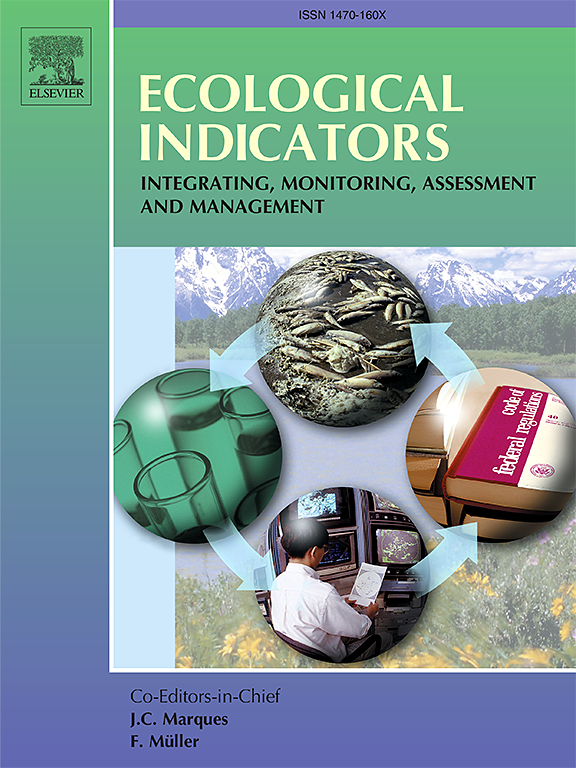Developing a multifunctional indicator framework for soil health
IF 7
2区 环境科学与生态学
Q1 ENVIRONMENTAL SCIENCES
引用次数: 0
Abstract
We developed a proof-of-concept indicator framework to monitor soil health based on the delivery of ecosystem services. Instead of distilling soil health to one metric, the framework enables simultaneous comparison of the delivery and trade-offs between different ecosystem services that are delivered by soils, accounting for inherent capability determined by soil type and land use. The framework has potential to explore a whole systems approach, ascertaining soil system response in real time that can detect emergent properties of the system. Initial development of the framework ranked salient soil properties known to be linked and pertinent to the delivery of ecosystem services. These key soil properties, together with other environmental variables were used to create simple conceptual models representing a causal network for soils’ contributions to the ecosystem services of climate regulation, food production, water regulation and below-ground biodiversity. The conceptual models were developed into Bayesian Belief Networks populated with relevant national data and expert judgement. The resulting outputs gave an indication of how well (i.e. healthy) a soil can deliver each ecosystem service at a land parcel scale presented in a dashboard app. The output at a specific location can be contextualised or benchmarked against to the range of values for areas with similar soil and land use types. The idea was to build the model with readily available data and knowledge but with flexibility for iterative development to refine the framework and models and improve outputs over time. This enables indicator updates using inputs of local knowledge of land management, or when additional soil data becomes available, or when soil policy drivers change, or our understanding of the conceptual and statistical models are improved. The indicator framework can be applied and adapted for use in multiple contexts from reporting national policy targets on soil health to determining soil health for a farmer at the field level.

制定土壤健康多功能指标框架
我们开发了一个概念验证指标框架,以提供生态系统服务为基础监测土壤健康。该框架没有将土壤健康提炼为一个指标,而是能够同时比较土壤提供的不同生态系统服务之间的交付和权衡,考虑到由土壤类型和土地利用决定的固有能力。该框架具有探索整个系统方法的潜力,可以实时确定土壤系统的响应,从而检测系统的紧急特性。该框架的初步发展对已知与提供生态系统服务相关的显著土壤特性进行了排序。这些关键的土壤特性与其他环境变量一起被用来创建简单的概念模型,代表土壤对气候调节、粮食生产、水调节和地下生物多样性等生态系统服务的贡献的因果网络。概念模型被发展成贝叶斯信念网络,其中包含了相关的国家数据和专家的判断。由此产生的输出显示了土壤在仪表板应用程序中呈现的地块尺度上提供每种生态系统服务的程度(即健康程度)。特定地点的输出可以根据具有相似土壤和土地利用类型的地区的值范围进行背景化或基准化。这个想法是用现成的数据和知识来构建模型,但要有迭代开发的灵活性,以改进框架和模型,并随着时间的推移改进输出。这样一来,就可以利用当地土地管理知识的输入,或者当有更多土壤数据可用时,或者当土壤政策驱动因素发生变化时,或者当我们对概念和统计模型的理解得到改进时,来更新指标。指标框架可以在多种情况下加以应用和调整,从报告有关土壤健康的国家政策目标到在田间一级确定农民的土壤健康。
本文章由计算机程序翻译,如有差异,请以英文原文为准。
求助全文
约1分钟内获得全文
求助全文
来源期刊

Ecological Indicators
环境科学-环境科学
CiteScore
11.80
自引率
8.70%
发文量
1163
审稿时长
78 days
期刊介绍:
The ultimate aim of Ecological Indicators is to integrate the monitoring and assessment of ecological and environmental indicators with management practices. The journal provides a forum for the discussion of the applied scientific development and review of traditional indicator approaches as well as for theoretical, modelling and quantitative applications such as index development. Research into the following areas will be published.
• All aspects of ecological and environmental indicators and indices.
• New indicators, and new approaches and methods for indicator development, testing and use.
• Development and modelling of indices, e.g. application of indicator suites across multiple scales and resources.
• Analysis and research of resource, system- and scale-specific indicators.
• Methods for integration of social and other valuation metrics for the production of scientifically rigorous and politically-relevant assessments using indicator-based monitoring and assessment programs.
• How research indicators can be transformed into direct application for management purposes.
• Broader assessment objectives and methods, e.g. biodiversity, biological integrity, and sustainability, through the use of indicators.
• Resource-specific indicators such as landscape, agroecosystems, forests, wetlands, etc.
 求助内容:
求助内容: 应助结果提醒方式:
应助结果提醒方式:


